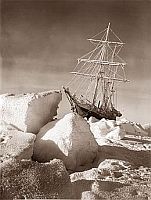
Shackleton’s Endurance
The press recently has been full of headlines about Ernest Shackleton‘s ill-fated ship, Endurance. The Christian Science Monitor asks, “What happened to Shackleton’s sunken ship?” Radio New Zealand answers the question with “Shackleton’s ship could still be in good condition.” The Raw Story takes a slightly different tack with “Scientists investigate the fate of ‘Endurance’ – explorer Ernest Shackleton’s sunken ship.” If you read the articles, however, it quickly becomes clear that they have relatively little to do with Shackleton or the Endurance, the explorer’s ship crushed by Antarctic ice, and everything with do with shipworms. Apparently the writers were concerned that readers might not care about ship worms, so they all lead with Shackleton.
The real news is that scientists have recently discovered that shipworms do not live in waters of the Antarctic. Wooden ships, including but not limited to Shackleton’s Endurance, may be well preserved, or at least not eaten by worms, on the ocean floor where they sank. For marine archaeologists, this could be a really big deal.
In a recent paper, Bone-eating worms from the Antarctic: the contrasting fate of whale and wood remains on the Southern Ocean seafloor, in the Proceedings of the Royal Society B, a groups of researchers monitored what happened to wood and whale bone underwater on the Southern Ocean seafloor. The whale bone was attacked by several species of bone-eating worm, while the worm was left untouched. Apparently, there are no shipworms in these Southern waters. The only other two areas of the ocean with a deficit of shipworms are the Baltic and the Black Sea, both of which are sufficiently brackish to be less attractive to the worms, which are technically a type of mollusk.
The Southern Ocean is not brackish, so why are there no ship worms? The answer appears to be that there are no trees. In fact, there have been no trees in the Antarctic region for something like 30 million years. There has been nothing for shipworms to eat, notwithstanding the occasional shipwreck. Bone-eating worms, however, have a rich source of food – whale bones. The Southern Ocean has one of the highest populations of whales of any ocean in the world. It is bone-worm heaven.
So the big news is that the Antarctic may be the new frontier of underwater archaeology. And yes, Shackleton’s Endurance may possibly be well preserved beneath the icy waters.
